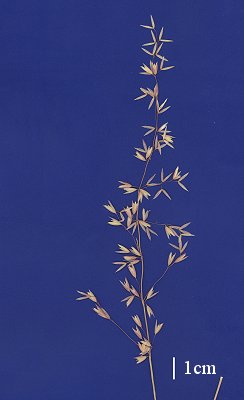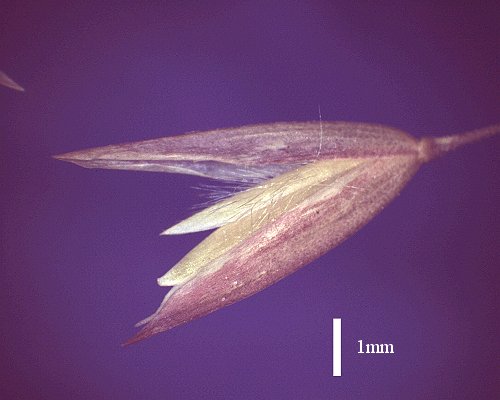Ehrharta calycina* Sm. Pl. Icon.
Hactenus Ined. 2, t. 33 (1790).
Classification. (GPWG 2001) : Subfamily Ehrhartoideae.
Tribe Ehrharteae.
Type of Basionym or
Protologue Information: E. Promontoria Bonne Spei, Sparrman s.n. (HT:
LINN).
Key references
(books and floras): [1952] C.A.Gardner, Flora of Western Australia 1
Gramineae (19), [2006] J.Jessop, G.R.M.Dashorst, F.M.James, Grasses
of South Australia (54), [2002] J.Wheeler, N.Marchant & M.Lewington,
Flora of the South West (414), [2006] J.Jessop, G.R.M.Dashorst, F.M.James, Grasses
of South Australia, [2008] S.W.L.Jacobs, R.D.B.Walley & D.J.B.Wheeler, Grasses
of New South Wales (233), [2009] A.Wilson (ed.). Flora of Australia,
Vol 44A. Poaceae 2 (373).
Illustrations:
[1952] C.A.Gardner, Flora of Western Australia 1 Gramineae (17
& 20, Pl.2 & 3), [1984] N.T.Burbidge. rev. S.W.L.Jacobs, Australian
Grasses (125), [2006] J.Jessop,
G.R.M.Dashorst, F.M.James, Grasses of South Australia (55, fig.19), [2008] S.W.L.Jacobs,
R.D.B.Whalley & D.J.B.Wheeler, Grasses of New South Wales, 4th edn
(233), [2009]. A.Wilson (ed.), Flora of Australia 44A: Poaceae 2
(372, Fig. 50; 378, Fig. 51).
Habit.
Perennial. Rhizomes absent or present, elongated. Stolons absent or present.
Culms geniculately ascending, 30–100 cm tall. Mid-culm internodes glabrous or
pubescent. Leaf-sheath auricles present. Ligule a fringed membrane, a ciliolate
membrane or a ciliate membrane, 2 mm long, membranous. Leaf-blades flat or
involute or convolute, 2–250 cm long, 1–10 mm wide.
Inflorescence.
Inflorescence compound, a panicle. Panicle linear or oblong, 5–25 cm long.
Spikelets.
Spikelets pedicelled. Fertile spikelets 1 or more flowered, with 1 fertile
floret, comprising 2 basal sterile florets, comprising 1 fertile floret(s),
without rachilla extension, cuneate, laterally compressed, 4–8 mm long.
Glumes. Glumes
similar, thinner than fertile lemma. Lower glume oblong, membranous, keeled,
7–9 -nerved. Upper glume oblong, 4–7 mm long, membranous, without keels, 9
-nerved. Florets. Basal sterile florets 2 or more, barren, without
significant palea. Lemma of lower sterile floret 80–90 % of length of spikelet,
coriaceous, 1-keeled, 5–7 -nerved, mucronate. Lemma of upper sterile floret 4–8
mm long, mucronate.
Fertile lemma 3.5–7.5
mm long, keeled, 5–7 -nerved. Lemma surface indumented. Palea 1–2 -nerved,
1-keeled. Lodicules present. Anthers 6.
Continental
Distribution: Africa, Australasia, and South America.
Australian
Distribution: Western Australia, South Australia, New South Wales,
Victoria, Tasmania.
Western Australia:
Carnarvon. Drummond, Dale. South Australia: Flinders Ranges, Eyre
Peninsula, Northern Lofty, Murray, Yorke Peninsula, Southern Lofty, Kangaroo
Island, South-eastern. New South Wales: North Coast, Central-Western
Slopes, South-Western Slopes, South-Western Plains. Victoria: East
Gippsland, Gippsland Plain, Grampians, Lowan Mallee, Midlands, Murray Mallee,
Otway Plain, Otway Range, Wilsons Promontory, Riverina, Volcanic Plain, Wannon,
Wimmera. Tasmania: Furneaux Group, North East, East Coast.
Notes.
Introduced; W.A., S.A., Vic., N.S.W., Tas. Often in coastal areas on sandy
soils.




